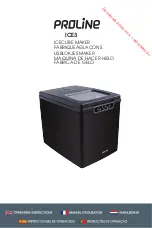
58
59
hot surfaces (e.g. burner, heater, or oven). Do not use the appliance
or any parts or accessories of the appliance with any other device
or for any other purpose than described in this booklet.
Do not place
the glass carafe of the appliance on a hot stove top.
• During operation keep the appliance in an appropriate distance of
at least 10 cm on each side (including the rear) to the wall and any
other objects. Ensure free access at the front and top of the appliance
and leave at least 50 cm of free space above the appliance, to avo-
id damage due to heat and moisture. Do not operate the appliance
under overhanging boards or drop-lights.
• This appliance can be used by persons with reduced physical, senso-
ry or mental capabilities or lack of experience and knowledge, inclu-
ding children aged from 8 years and above, if they have been given
supervision or instruction concerning the use of the appliance in a safe
way and understand the hazards involved. Even care and cleaning
shall not be performed by children without supervision.
•
Children must always be supervised to ensure that they do not play
with the appliance or any parts of the appliance or the packaging.
Always keep the appliance where it is dry, frost-free, and clean, and
where young children cannot reach it. Do not leave the appliance or
any part of it unattended, when in reach of young children.
• Do not place any clothes or tissues on or under the appliance during
operation, to avoid overheating, fire and electric shock. Do not place
any heavy and/or sharp-edged foreign objects on or in the appliance
or any of its parts (e.g. heating plate, glass carafe, or water tank), to
avoid damage.
Handle the glass carafe (including the carafe lid)
with special care as it is fragile. Avoid extreme variations in tem-
perature
(e.g. pouring cold water into the hot glass carafe).
Avoid
knocking the glass carafe against hard or sharp-edged objects.
Otherwise the glass carafe could crack. Do not use the glass cara-
fe any longer, when there are any chipped edges or cracks.
Even
small splinters and shards in your beverages may cause severe
injuries.
Do not use the glass carafe, if the carafe lid or handle are
damaged, loose, worn out, or distorted in any way to avoid overflow
of hot liquid causing injuries and damage.
The carafe lid cannot be
removed!
The appliance is suited for partly unattended operation.
However, do not leave the appliance connected to the power supply
uselessly. Always unplug the appliance, if you do not wish to use the
appliance for an elongated time period and before cleaning.
• Before operating the appliance (via on/off button or timer button),
always ensure that the appliance is in safe operation order and com-
pletely and correctly prepared for operation (see: ‘Brewing Coffee’).
Do not use violence. Do not press on the filter holder or the open
water tank lid.
Do not use any other but the designated glass cara-
fe and filter basket with the appliance. The carafe lid opens the
drip-stop valve of the filter basket. With any other combination of
parts, the filter basket will overflow, causing risk of damage and
severe injuries due to hot water running out.
For operation, only fill
cold, fresh tap water or bottled table water with low mineral content
in the water tank.
Do not fill hot water into the water tank.
• Do not fill the water tank above the maximum filling level 12 (1.5 litres).
Otherwise, water could run out and cause hazards due to overheating,
fire, and electric shock. When filling, ensure that the water will not run
down at the sides or the rear of the appliance. Always wipe off spilled
liquids immediately. If water runs out or is spilled on the housing, imme-
diately unplug the appliance. Then wipe dry and leave the appliance
dry naturally for at least 1 day.
Do not pour or spill water or any other
liquid into the bean hopper to avoid damage!
The opening for filling
of the water tank is behind the bean hopper!
Do not fill non-roasted,
stale, or moist coffee beans or any foreign materials into the bean
hopper. Do not attempt to remove the bean guiding cone (in the cen-
tre of the bean hopper). Do not push coffee beans under the bean
guiding cone to avoid blocking the grinder.
• Do not fill coffee powder directly into the filter basket. Always place
a suitable filter into the filter basket, before filling in coffee powder
and/or starting the brewing cycle with grinder operation. When
using pre-ground coffee powder, do not fill in more than 60 g coffee
powder to avoid overflow (max. 12 level measuring spoonful). Duri-
ng operation, you may take out the glass carafe for some seconds.
However, the drip-stop valve could get blocked by coffee powder in
















































